A Lightweight Dynamic Hierarchical Neural Network Model and Learning Paradigm
Abstract
In image analysis scenarios such as the Internet of Things and the metaverse, the introduction of federated learning (FL) is an effective solution to safeguard user data security and meet low-latency requirements during the machine learning process. However, due to the constrained computational power and memory of devices, facilitating the local training of complex models becomes challenging, thereby posing a significant obstacle to the application of FL. Consequently, a lightweight dynamic hierarchical neural network model and its learning paradigm are proposed in this study. Specifically, a lightweight compression method is designed based on enlarged receptive fields and separable convolutions to reduce redundancy in convolutional layer feature maps. A dynamic model partitioning method is devised, grounded in the Q-Learning reinforcement learning algorithm, to enable collaborative model training across multiple devices and enhance the utilization efficiency of device computing and storage resources. Furthermore, a hierarchical federated partition learning (HFSL) paradigm based on complete weight sharing is introduced to facilitate the compatibility of partitioned models with FL. Experimental results show that our lightweight model outperforms existing models in terms of accuracy, lightweight degree, and efficiency on image analysis tasks. Moreover, the proposed HFSL paradigm achieves performance comparable to centralized training.
1. Introduction
In the current digital era, research on machine learning (ML) models within the context of the Internet of Things (IoT) and metaverse has increasingly become a focal point for cutting-edge technology and business innovation [1]. Using the vast amounts of data generated by devices for ML, particularly through convolutional neural networks (CNNs), can significantly enhance the automation and intelligence of systems. For instance, through the utilization of image data captured by cameras in factory settings to train CNN models, it becomes possible to offer diagnostic services for safety incidents within industrial facilities, while also facilitating high-quality image analysis for industrial metaverses. Typically, constructing high-accuracy CNN models requires collecting extensive training data. However, transmitting raw data from devices to a central node may raise concerns issues of user privacy and data security. Federated learning (FL), as an emerging distributed ML paradigm, enables model training and refinement without sharing sensitive data. Specifically, during each FL epoch, the CNN model undergoes local training on devices using their private datasets. The locally trained model parameters are aggregated by a centralized server, which updates the global model parameters through a model aggregation algorithm [2]. In contexts like the IoT and the metaverse, FL serves to tackle challenges in terms of data centralization and privacy breaches. Simultaneously, it optimizes the utilization of computational resources from edge devices, thereby mitigating communication overhead [3]. By conducting model training on devices and sharing only model parameters rather than raw data, the risk of data leakage can be effectively reduced, and response times improved. Consequently, FL has been widely adopted in the scenarios such as smart factories, virtual reality, smart homes, and smart cities.
In FL, CNN models are deployed and trained on devices, necessitating each device to possess sufficient computational and storage resources for executing the training tasks. Nevertheless, most devices commonly do not have such computational capabilities and memory for this training purpose, which brings barrier for FL to be practically applied [4]. Take VGG-16 as an example, whose parameters are up to 138 million, occupies over 552 MB of storage space, and requires 15.3 billion floating-point operations (BFLOPs) for processing a single image [5]. As neural networks scale up, both compute and storage requirements increase simultaneously, raising hurdles for devices that may find even the inference phase burdensome. Current research primarily focuses on model compression and pruning techniques, which aim to diminish parameter count and computation but often at the expense of model accuracy. Hence, the obstacle persists in designing lightweight model and distributed learning methodologies capable of adapting to the resource limitations of devices.
- •
A model lightweighting method based on enhanced receptive fields and separable convolutions is put forward, which minimizes the number of parameters and computational volume. Concurrently, this approach captures more distant contextual information to enhance the model’s expressive capacity;
- •
A model dynamic splitting mechanism grounded in the Q-Learning algorithm is introduced, utilizing the Gradient-weighted Class Activation Mapping (Grad-CAM) algorithm to identify optimal splitting points for the model and enabling the intelligent agent to dynamically determine the best split points;
- •
Experimental results demonstrate that the refined model has 6.424 million (M) parameters, representing a reduction of 29.48%; the computational volume is 0.421 BFLOPs, displaying a decrease of 58.73%. Moreover, the model achieves a Top-1 accuracy of 71.0%, and a Top-5 accuracy of 90.0%, with only a 1.1% decrease, outperforming other similar models. Under the hierarchical federated SL (HFSL) paradigm with complete parameter sharing, accuracy remains comparable to the unsplit one.
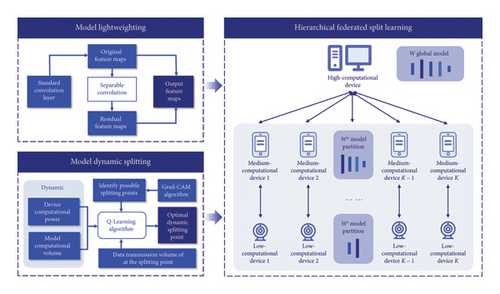
The remainder of this paper is organized in the following manner. Section 2 reviews the related work. Section 3 provides a detailed explanation of the proposed lightweight CNN model, the model’s dynamic splitting method, and the HFSL paradigm. Section 4 describes and analyzes the experimental process and results. Lastly, Section 5 brings this paper to a conclusion.
2. Related Works
2.1. Lightweight Model
Lightweight models are key for FL on devices, with techniques like compression, direct design, and neural architecture search (NAS) that reduce parameters and complexity.
In model compression, Ren et al. [7] proposed an adaptive knowledge distillation method compressing multiple teacher models into a single student model. Liu et al. [8] introduced a discrimination-aware channel pruning method which identifies key channels per layer based on discriminative loss and reconstruction, removing non-essential channels. Du, Ma, and Liu [9] presented a compression method based on knowledge distilling and adversarial learning to address model redundancy. Researchers have also explored the direct design of efficient neural networks, such as SqueezeNet [10], a CNN with an asymmetric U-shaped architecture that employs attention mechanisms to emphasize relevant features and suppress irrelevant ones through attention gates in its skip connections. ShuffleNets [11] leverage grouped convolutions and channel permutation, dividing large kernels into smaller ones for efficient computation within CNN models. MobileNets [12] are deep CNN models specifically designed for mobile devices, utilizing depthwise convolution and pointwise convolution. In NAS, Yin, Chen, and Tao [13] proposed a NAS algorithm based on policy gradient reinforcement learning and the parameter-sharing to minimize device energy consumption and model error. Shen et al. [14] presented an evolving deep multiple kernel learning network through genetic algorithm to find the best deep multiple kernel learning structure, including the weights and the topology of the model.
Model compression may impair accuracy and generalization, as reducing the model size can limit its expressiveness. The design of a tiny often leads to trade-offs in performance, making it harder to capture complex patterns. Additionally, the NAS requires substantial computational resources and time costs, making it impractical for certain applications. We propose a method enhancing high-dimensional feature maps without reducing channels, by modifying convolutional operations to lower computational load while preserving accuracy.
2.2. Model Splitting Point Selection
The selection of model splitting points is a research endeavor conducted within distributed learning scenarios to fully leverage the computational resources of different nodes, enabling the distributed processing of models and data. Shao and Zhang [15] introduced a framework with model splitting, communication-aware compression, employing exhaustive search to determine the model splitting points. Wang et al. [16] proposed a multiobjective mechanism that minimizes communication costs by transforming the multisplit issue into a minimal cost graph search and optimizing distributed algorithms. Wu et al. [17] utilized reinforcement learning and clustering to dynamically determine layer offloading for models, addressing computational heterogeneity and variable network bandwidth. Yan, Bi, and Zhang [18] investigated the joint optimization of model placement and online model splitting decisions under wireless channel fading conditions to minimize the time and communication costs for edge collaborative inference of devices. Tuli, Casale, and Jennings [19] employ decision-aware reinforcement learning to optimize between layer and semantic splitting strategies for neural network tasks on mobile edge devices, ensuring efficient and scalable computation based on service deadline requirements.
Significant research has been dedicated to refining model splitting strategies to enhance accuracy and decrease computational demands. Yet, existing methods often lack the flexibility to respond to dynamic environmental changes, leading to suboptimal performance in real-time applications. To improve performance and reduce latency, considering device and model adaptability, adaptive and dynamic model splitting strategies are essential to address fluctuating environmental conditions and ensure efficient resource utilization.
2.3. Distributed Learning Paradigm
The centralized training on large cloud servers is becoming unsustainable. To protect user privacy and ensure timely model convergence, researchers have proposed various distributed learning paradigms. For instance, FL [2] employs data from multiple clients to train neural network models, utilizing a parameter server to compute and distribute the average weights among clients. SL [20] involves the server splitting the global model parameters into multiple partitions, which are then trained sequentially with each client. After the initial client’s training is complete, its weights are shared with the next client in the training sequence. Combining FL and SL, various hybrid training methods have been introduced. Parallel SL [21] is a variant of SL where the server simultaneously trains client output on multiple batches in parallel. The client’s weight is kept confidential, while just the server’s weight is updated and transmitted. Federated reconstruction [22] parallelizes local and global weight training across clients, retaining only averaged global weights after each epoch to safeguard data privacy. Federated SL [23] combines edge servers with parallel client training, with edge weights aggregated by a parameter server and client weights kept private. Federated Edge Learning [24] is an extension of the FL paradigm, tailored to leverage the capabilities of edge computing. In a federated edge learning system, multiple edge devices collaborate to train a shared ML model while keeping the data decentralized and private.
These paradigms favor data privacy over shared client-side model weights, accepting some accuracy trade-off. However, local area networks of IoT and the metaverse, recognized as secure zones for authorized devices and users, offer a platform for extensive data sharing with controlled access. We propose a HFSL paradigm that, through complete weight sharing, diminishes the computational burden on devices, increases training data volume, and upholds both accuracy and data security, while ensuring that privacy concerns are effectively addressed.
3. Proposed Methodology
3.1. Design of Model Lightweighting
Models such as ShuffleNet [11] and MobileNet [12] have introduced depthwise convolutions or shuffle operations, employing smaller convolutional filters to construct efficient CNNs [25]. However, the remaining 1 × 1 convolutional layers still occupy a significant amount of memory and computational resources [26]. Additionally, through feature map visualization techniques, it has been observed that standard traditional convolutional operations exhibit similar feature map information, leading to computational redundancy in the model. To reduce the computation of 1 × 1 convolutions and the extensive redundancy present in feature maps within CNN models, we propose improvements to the convolutional layers of the CNN. For each convolutional layer, a small number of original feature maps are output through standard traditional convolutional operations, and the residual feature maps are generated using depthwise separable convolution operations based on the original feature maps, while retaining the identity mapping of the convolutional layer. This approach reduces the computational power required to generate partial feature maps, diminishes model feature map redundancy, and decreases the model’s computational overhead.
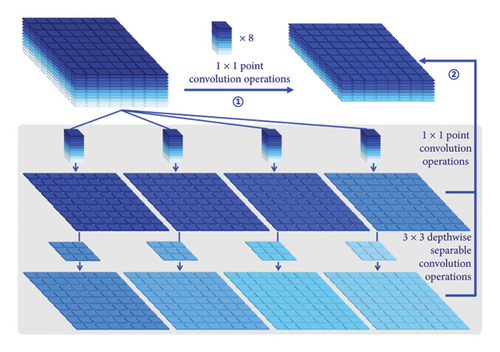
3.2. Design of Model Dynamic Splitting
To address the issue of insufficient computational capacity on individual device, it is feasible to split the model into submodels, which are then trained across different devices, thereby facilitating the training of the global model. When designing the model splitting points, it is crucial to consider the computational load and data volume of each segment, while also taking into account the dynamic changes in device computing power and their impact on model accuracy. Consequently, we have designed a model dynamic splitting mechanism based on reinforcement learning algorithms, utilizing the Q-Learning algorithm and Grad-CAM algorithm to determine the dynamic optimal splitting points for CNN models. The Grad-CAM algorithm assesses the importance of feature maps by calculating the gradients of neurons, where the gradient refers to the partial derivative of the neuron’s output with respect to the decision towards the correct category. The specific Grad-CAM algorithm is designed as follows:
Thus, determine the optimal splitting point by analyzing the values of the CUmulated Importance (CUI) curve. Utilize the value of the j-th data point in the o-th classification at the i-th layer of the model, fit the values in the o-th classification data to form the curve, and then perform linear fitting on the curves of all classification images to obtain the model’s CUIi curve. Define the local maximum values on the CUIi curve as the possible splitting points on the model, which is the action space Dt.
- 1.
Define the state space: Considering the changing remaining computational power of devices, the state space is defined as the St = (al, am, bl, bm) vector, where al represents the remaining computational power of low-computational devices, am represents that of medium-computational devices, bl is the computational power size of the model’s Wl partition, and bm is that of the model’s Wm partition. The calculation of the remaining computational power of devices is defined as a = δ × ETOPS, where the device’s computational power is ETOPS, and the CPU occupancy rate in the current environment of the device is δ.
- 2.
Define the reward function: The reward function can be defined as the reward obtained after executing a certain action in the current state. In this case, the reward function can be defined as the inference latency of the model and its compatibility with the state space. If the model requires less time to complete the inference task, a higher reward value should be given. The model’s inference time can be used as an input parameter, with the output being a reward value that is negatively correlated with the inference time. Further normalization of each influencing factor is necessary for ease of computation. The reward function is calculated as illustrated in equation (6).
() -
where k1, k2, and k3 are parameters used to adjust the impact of various factors on the reward, determined by the needs in different scenarios, with time being the sum of the model’s inference time and communication time, calculated as shown in equation (7).
() -
where V is the transmission rate, with standard Ethernet data transfer speeds ranging from 10 Mbps to 100 Mbps, calculated in this paper using a theoretical speed of 50 Mbps, equivalent to 6.25 Mb/s. inputsize is the size of the data transmission at the model’s splitting point. Initialize the Q-value table to 0, with Q-value representing the expected return value for taking a certain action in a given state.
- 3.
Iterative training: At each time step, the agent selects an action from the Q-value table based on the current state and executes the action. After executing the action, the agent observes the reward signal feedback from the environment and updates the values in the Q-value table according to the feedback using the Q-Learning greedy strategy. The greedy strategy selects the action with the highest Q-value as the next action based on the current state’s Q-value table. The Q-function is described as equation (8).
() -
where β is the learning rate and γ is the discount factor. This encourages the agent to selecting actions with the highest Q-value during the learning process, thereby learning the optimal splitting strategy. By dynamically determining the optimal splitting point, the CNN model W is split into two partitions, Wl and Wm, referred to as the low-computational network and the medium-computational network, processed and calculated on low-computational and medium-computational devices, respectively.
3.3. Design of the HFSL Paradigm
A hierarchical grouping based on the computational power of devices is proposed, categorizing them into high-computational devices capable of 10–100 BFLOPS, such as local servers and edge servers; medium-computational devices with 1–10 BFLOPS, including desktop computers, tablet computers, and gateways; and low-computational devices with 0–1 BFLOPS, such as cameras, virtual reality glasses, and smart wristbands [27]. Leveraging the respective strengths of FL and SL, while also accommodating the characteristics of the splitting model, our design facilitates the complete sharing of model weights. We have developed a HFSL paradigm based on complete weight sharing, as illustrated in Figure 3. This learning paradigm consists of one high-computational device, K medium-computational devices, and K low-computational devices, with the specific training steps as follows:
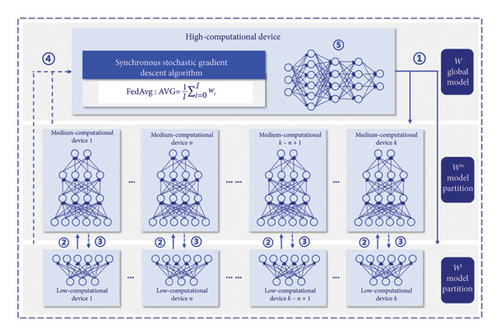
- 1.
The Wl partition of the CNN model is sent to the low-computational devices for training, which are typically the original data collection devices. The Wm partition of the CNN model is placed on the medium-computational devices for training, while the entire CNN model is subjected to weight aggregation and inference on the high-computational devices;
- 2.
The neural network of the Wl partition begins forward propagation on the low-computational devices, which then sends intermediate data, known as smashed data, to their corresponding medium-computational devices for the forward propagation operation of the model Wm partition. The pseudo-code for the operations executed on the low-computational devices is provided in Algorithm 1.
- (3)
Upon obtaining their output labels and calculating the loss function value, the medium-computational devices initiate backward propagation. After the gradient calculation at the splitting layer is completed on the medium-computational devices, the gradients are sent back to the low-computational devices for the backward propagation computation of the Wl partition. The pseudo-code for the operations executed on the medium-computational devices is provided in Algorithm 2.
- (4)
The respective low-computational and medium-computational devices send the weight parameters computed from the two partitions to the high-computational device to execute the FedAvg algorithm, updating the global CNN model. The updated weight parameters are then sent back to the low-computational and medium-computational devices for the next round of training. The pseudo-code for the operations executed on the high-computational devices is provided in Algorithm 3.
- (5)
Through multiple iterative training rounds, training is terminated once the CNN model on the high-computational device achieves the desired level of accuracy. Inference is ultimately conducted on the high-computational device, and the results are subsequently transmitted to the corresponding devices for execution.
-
Algorithm 1: Runs on low-computational device.
-
Ensure: LowUpdate :
- 1.
Model updates ⟵ High-computational Device ()
- 2.
Set Ak,t = ∅
- 3.
for each local epoch e from 1 to Edo
- 4.
Forward propagation with data Xk up to a layer L ≥ 1 in ;
- 5.
Continue forward propagation to the remaining layers of , and get the activations of its final layer Ak,t;
- 6.
Yk is the true labels of Xk;
- 7.
Send Ak,t and Yk to the medium-computational device;
- 8.
Wait for the completion of LowBackprop (dAk,t);
- 9.
end for
-
Ensure: LowBackprop (dAk,t):
- 10.
while local epoch e ≠ Edo
- 11.
dAk,t ⟵ Medium-computational Device();
- 12.
Back-propagation, calculate gradients with dAk,t;
- 13.
Send to the High-computational device;
- 14.
end while
-
Algorithm 2: Runs on medium-computational device.
-
Ensure: MediumUpdate :
- 1.
if time instance t = 0then
- 2.
Model updates ⟵ High-computational Device ();
- 3.
else
- 4.
for each low-computational device k ∈ St in parallel do
- 5.
while local epoch e ≠ Edo
- 6.
(Ak,t, Yk) ⟵ LowUpdate
- 7.
Forward propagation with Ak,t on , compute ;
- 8.
Loss calculation with Yk and ;
- 9.
Back-propagation calculate ;
- 10.
Send (i.e., gradient of the Ak,t)
- 11.
to medium-computational device k for LowBackprop (dAk,t);
- 12.
end while
- 13.
end for
- 14.
Send to the high-computational device;
- 15.
end if
-
Algorithm 3: Runs on high-computational device.
-
Ensure: HighExecutes :
- 1.
if time instance t = 0then
- 2.
Initialize (low-computational network);
- 3.
Send to all K low-computational devices for LowUpdate ;
- 4.
Initialize (medium-computational network)
- 5.
Send to all H medium-computational devices for MediumUpdate ;
- 6.
else
- 7.
for each low-computational device k ∈ St in parallel do
- 8.
⟵ LowBackprop (dAk,t);
- 9.
each medium-computational device k ∈ St in parallel do
- 10.
⟵ MediumUpdate ;
- 11.
end for
- 12.
Low-computational network updates: ;
- 13.
Send to all K low-computational devices for LowUpdate ;
- 14.
Medium-computational network updates: ;
- 15.
Send to all K medium-computational devices for MediumUpdate ;
- 16.
end if
4. Experimental Results and Analysis
4.1. Experimental Environment and Datasets
The experimental environment was configured as follows: in terms of software, the operating system was Linux and the programming language was Python 3.8.0, using PyTorch as the deep learning framework. In terms of hardware configuration, the system is equipped with a 16-core CPU, 16 GB of RAM, and a 300 GB hard drive, and the Graphics Processing Unit (GPU) is an NVIDIA GeForce RTX 2080 Ti with 11 GB of GDDR6 video memory and CUDA version 11.4.
The performance of the model on the ImageNet-1K image classification dataset (ILSVRC2012) is evaluated in this study. The ImageNet-1K dataset includes 1.28 million training images and 50,000 validation images, all sized at 224 × 224. This extensive dataset covers 1000 different classes, with each class containing a minimum of 1000 images. The images are diverse, capturing a wide range of objects from the natural world, such as animals and plants, as well as man-made objects like vehicles and household items. The dataset is used to measure the accuracy of models, with performance typically reported in terms of top-1 and top-5 accuracy, which refer to the model’s ability to select the correct class as the first or within the top five choices, respectively. Images were normalized for mean and standard deviation prior to training. Specifically, the pixel values of each channel in the images were subtracted by the mean and divided by the standard deviation to center the pixel values around 0.
Additionally, weights were initialized before model training; convolutional layers employed the Kaiming initialization method, calculating the standard deviation of weights based on the weight tensor’s shape and “fan_out” approach, initializing weights to random values following a normal distribution; batch normalization layers initialized weights to 1 and biases to 0; fully connected layers initialized weights using a normal distribution with a mean of 0 and a standard deviation of 0.01, with biases set to 0. We then utilized the stochastic gradient descent optimizer to update model parameters, setting the lr learning rate parameter to 0.01, the momentum parameter to 0.9, and the weight_decay parameter to 1E − 4. The learning rate was adjusted using the cosine annealing strategy, with a batch size of 64.
4.2. Model Lightweighting Experiment
The advanced MobileNet block structure, renowned for its efficiency and widespread application, was chosen to reduce model redundancy, becoming the foundation of choice for many lightweight deep learning models. The improved lightweight block structure, denoted as MBConv-s, is illustrated in Figure 4, with the enhancements marked within the dashed. Concurrently, as the EfficientNet model is derived from NAS methods, it incorporates optimized channel and layer counts [28]. Leveraging the optimal channel and layer configurations from the EfficientNet model, we applied the MBConv-s block structure to the EfficientNet-B2 model, resulting in our refined lightweight model structure, termed EfficientNet-B2s. The EfficientNet-B2s model comprises a stem_conv, 23 MBConv-s block, a top layer, and an avgpool, as detailed in Table 1.
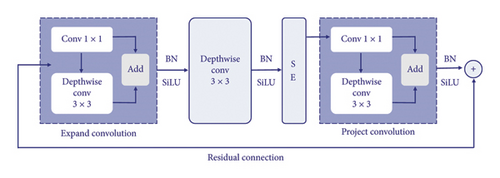
| Stage | Operator | Resolution | Channels | Layers |
|---|---|---|---|---|
| stem_conv | Conv3 × 3 | 224 × 224 | 32 | 1 |
| 1 | MBConv-s, k3 × 3 | 112 × 112 | 16 | a, b |
| 2 | MBConv-s, k3 × 3 | 112 × 112 | 24 | a, b, c |
| 3 | MBConv-s, k5 × 5 | 56 × 56 | 48 | a, b, c |
| 4 | MBConv-s, k3 × 3 | 28 × 28 | 88 | a, b, c, d |
| 5 | MBConv-s, k5 × 5 | 14 × 14 | 120 | a, b, c, d |
| 6 | MBConv-s, k5 × 5 | 14 × 14 | 208 | a, b, c, d, e |
| 7 | MBConv-s, k3 × 3 | 7 × 7 | 352 | a, b |
| Top | Conv1 × 1 | 7 × 7 | 1408 | 1 |
| Avgpool | AdaptiveAvgPool | 7 × 7 | 1408 | 1 |
The training process before and after the model lightweight improvement is shown in Figure 5, and the comparison is shown in Table 2. It can be observed that the model’s accuracy and loss both converge better. The results indicate that our method of reducing model redundancy achieved significant improvements over the baseline model, with the model parameter count decreasing from 9.110 M to 6.424 M, a reduction of 29.48%; the model computational volume decreased from 1.020 BFLOPs to 0.421 BFLOPs, a reduction of 58.73%; meanwhile, the model storage space decreased by 28.87%, and the overall computational cache decreased by 29.08%. The model’s Top-1 accuracy is 71.0%, with only a 1.8% decrease, and the Top-5 accuracy is 90.0%, with only a 1.1% decrease. Our method significantly reduces model redundancy and computational costs while minimizing the loss of model accuracy, enhancing computational efficiency and achieving model lightweighting by replacing a large number of 1 × 1 point convolutions in the EfficientNet-B2 model with 3 × 3 depthwise separable convolutions, extracting feature maps with different receptive fields. We utilized visualization techniques to obtain feature maps generated by the convolutional layers, revealing that the EfficientNet-B2 model contained some similar feature maps with redundant information, as indicated by the same-colored frames in Figure 6(a). In contrast, the EfficientNet-B2s model reduced redundant feature maps and increased feature maps with higher-dimensional information, as boxed in Figure 6(b). Our method greatly reduces the redundancy and computational costs of the model, improving computational efficiency and achieving model lightweighting.
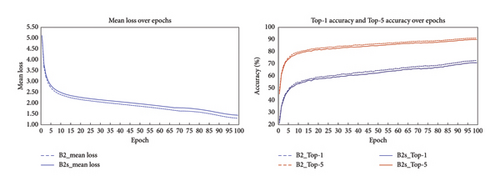
| Model | Params (M) | FLOPs (B) | Model size (MB) | Total memory (MB) | Top-1 Acc (%) | Top-5 Acc (%) |
|---|---|---|---|---|---|---|
| EfficientNet-B2 | 9.110 | 1.020 | 37.019 | 163.530 | 72.8 | 91.1 |
| EfficientNet-B2s | 6.424 | 0.421 | 26.331 | 115.970 | 71.0 | 90.0 |
| Improve | −29.48% | −58.73% | −28.87% | −29.08% | −1.8 | −1.1 |
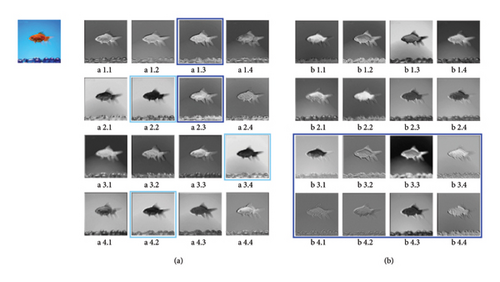
Representative models were selected for comparison, encompassing traditional convolutional, transformer-enhanced, and NAS-derived models. The comparison is presented in Table 3. The comparison shows that the computational volume of the EfficientNet-B2s model is only 35.0% of the most accurate DeiT-T model but with an accuracy difference of only 1.2%. Compared to GoogLeNet v1, SqueezeNet, ResNet-18, MobileNet v1, ShiftNet-A, MobileViTV2-0.5, and PVTv2-B0, the EfficientNet-B2s model offers higher accuracy and less computational volume. Additionally, it is observed that the EfficientNet-B2s model has a larger number of parameters than other models, which enhances the model’s performance across various tasks, including accuracy and generalization capabilities. Whether comparing model accuracy at equivalent computational volumes or comparing computational volumes at similar accuracies, our improved EfficientNet-B2s model possesses superior lightweighting advantages, making it more suitable for deployment and application in resource-constrained environments.
| Model | Params (M) | FLOPs (B) | Top-1 Acc (%) | Top-5 Acc (%) |
|---|---|---|---|---|
| VGG-16 [5] | 138.000 | 15.300 | 71.3 | 90.0 |
| GoogLeNet v1 [29] | 6.798 | 1.550 | 69.8 | 90.9 |
| SqueezeNet [10] | 1.250 | 0.720 | 60.4 | 82.5 |
| ResNet-18 [30] | 11.700 | 1.800 | 70.6 | — |
| MobileNet v1 [12] | 4.250 | 0.569 | 70.6 | 89.5 |
| ShiftNet-A [31] | 4.100 | 1.400 | 70.1 | 89.7 |
| Taylor-FO-BN [32] | 7.900 | 1.300 | 71.7 | — |
| RigL [33] | 1.280 | 0.320 | 67.5 | — |
| HRank [34] | 13.800 | 1.600 | 72.0 | 91.0 |
| T2T-ViT-7 [35] | 4.300 | 1.100 | 71.7 | — |
| DeiT-T [36] | 5.700 | 1.200 | 72.2 | — |
| MobileViTV2-0.5 [37] | 1.400 | 0.466 | 70.2 | — |
| PVTv2-B0 [38] | 3.400 | 0.600 | 70.5 | — |
| WD-pruning [39] | 3.500 | 0.700 | 70.3 | 89.8 |
| DeiT-T-X-pruner [40] | — | 0.600 | 71.1 | 90.1 |
| FLatten-PVTv2-B0 [41] | 3.600 | 0.600 | 71.1 | — |
| MGPF-VGG-16 [42] | 8.280 | 5.500 | 71.0 | — |
| DeiT-P6 [43] | 3.800 | 0.900 | 70.3 | — |
| EfficientNet-B2s (ours) | 6.424 | 0.421 | 71.0 | 90.0 |
4.3. Experiment on Model Dynamic Splitting
Firstly, the scope of the action space is ascertained initially through preliminary selections of splitting points. The model is structured around components such as stem, block, top, and avgpool. Considering that the convolutional backbone of the model is designed with blocks as the fundamental unit, splits are made at the block level to preserve the integrity of the basic block structure, while the final classifier, being the output layer, is not considered for splitting. We then utilize the gradient parameters saved during the training process of the EfficientNet-B2s model and employ the Grad-CAM algorithm to calculate the CUI values. These values are visualized using a line chart, with star markers indicating local maxima in the CUI curve, as depicted in Figure 7. By analyzing the CUI importance curves, we identify optimal candidate splitting points as 1b, 2b, 3c, 4b, 5b, and 6b; if the splitting point is 1b, the model is split after the 1b-block. The CUI values serve to measure the importance of each block in the model’s prediction of the correct category. Blocks with high CUI values indicate a pivotal role in making correct predictions, containing significant information related to the correct category. Therefore, when selecting the best splitting point, priority is given to preserving these key pieces of information to ensure that the model maintains high accuracy post-split.
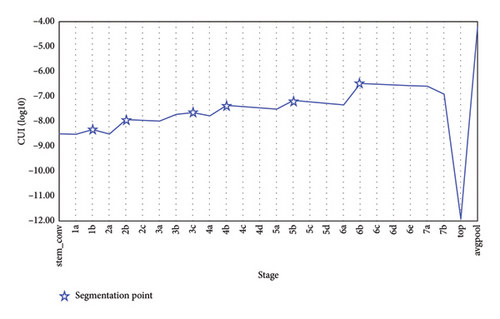
Secondly, reinforcement learning training is conducted using the state space parameter data derived from a simulated environment. The selection of splitting points is determined by the computational resource constraints of devices. The remaining computational power values of low-computational and medium-computational devices are simulated using an exponential distribution. The remaining computational power values of low-computational devices are constrained within the range of 0-1, while those of medium-computational devices are constrained within the range of 0–10, effectively mirroring the computational capabilities of real devices. Split candidate points, such as 1b, 2b, 3c, 4b, 5b, and 6b, defined in the action space, are used to calculate the computational volume data for each segment of the post-split model. The data volume at the model splitting point is derived from the computation of CUI values, as illustrated in Figure 8. Subsequently, after establishing the state space parameters and defining the action space scope, Q-Learning reinforcement learning iterative training is initiated, and the Q-values are updated based on the designed reward function. Through continuous interaction with the environment and learning, the agent can progressively refine its strategy, making optimal decisions based on the current state space parameters.
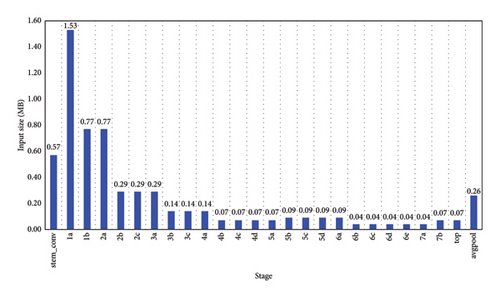
Finally, for a more effective presentation of the training results, visualization charts are utilized to illustrate the relationship between states and optimal splitting points in a more intuitive manner. The split points with the highest corresponding reward values under specific states, which are also identified as the optimal splitting points determined by the agent in that state, are selected for visualization, as depicted in Figure 9. It can be observed that when the remaining computational power value of low-computational devices exceeds that of medium-computational devices, the optimal splitting point is 6b, and the agent prefers to keep most of the model computation on the low-computational devices. When the remaining computational power value of low-computational devices is less than that of medium-computational devices, the optimal splitting points are 1b or 2b, and the agent tends to offload most of the model computation to medium-computational devices. Overall, as the remaining computational power value of the devices gradually increases, the agent tends to determine the best splitting point as 2b. This propensity stems from the medium-computational devices’ greater capability in handling more data and conducting more complex inferences; thus, making decisions at earlier splitting points can maximize rewards and minimize inference time.
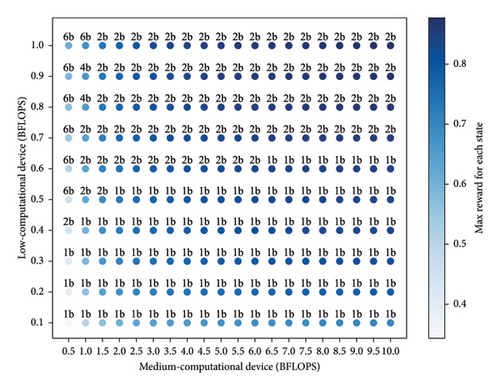
4.4. HFSL Paradigm Experiment
Given that numerous articles have already validated the feasibility of end-to-end deep learning [44, 45], this paper directly proceeds to HFSL experiments to verify whether model splitting impacts the model’s accuracy. In the experiments, we selected five GeForce RTX 2080 graphics cards to conduct the experiments, simultaneously training two sets of models to simulate the training architecture of HFSL. The results of the centralized learning training, FL training, SL training, and HFSL training are shown in Figure 10.
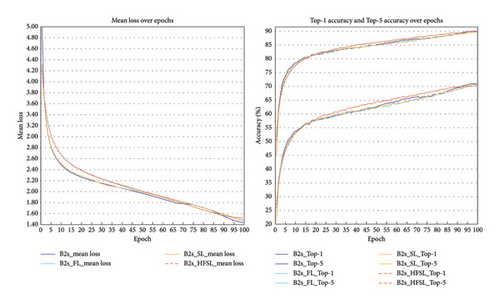
The experimental results indicate that the Top-1 accuracy is 70.7%, and the Top-5 accuracy is 89.9%. In terms of accuracy, the split model’s performance on the test set is essentially consistent with that of the unsplitting model, fluctuating within an acceptable range. This demonstrates that splitting does not significantly impair the model’s predictive capability. The complete sharing of weight parameters mitigates the loss of accuracy, as shared parameters enhance the model’s generalization and resistance to overfitting. Specifically, when weight parameters are fully shared, the sub-models resulting from the split will shar e the same parameters, implying that they influence and update each other during training. This results in a more consistent and stable feature representation learned by the global model. In terms of training speed, since the model is split into two parts and trained on different devices concurrently, the processing load is reduced, and training speed is improved. In contrast to centralized learning training, FL training, and SL training, the proposed HFSL paradigm effectively balances communication, computation, and model robustness. While FL excels at preserving privacy, it incurs higher communication costs, and SL offers advantages in reducing model size but may experience slower convergence. The HFSL paradigm, however, distributes computational tasks across multiple devices for parallel processing, improving computational resource utilization and efficiency. Additionally, since each submodel processes only partial data, the parameter updates in HFSL are more stable, which helps prevent overfitting and enhances the overall robustness of the model. This makes HFSL a more efficient and stable alternative, especially in distributed IoT and metaverse environments.
5. Conclusion
In this study, a lightweight dynamic hierarchical neural network model and its learning paradigm were proposed to advance the application of FL in IoT and metaverse scenarios. To mitigate the redundancy of convolutional layer feature maps and reduce model computational overhead, a block structure based on enhanced receptive fields and depthwise separable convolutions was designed. To tackle the computational resource constraints of devices and dynamically align device computational power with model size, a model dynamic splitting method based on the Q-Learning algorithm was introduced. To establish a distributed learning paradigm compatible with the splitting model and facilitate comprehensive sharing of device parameter data, a HFSL paradigm was proposed. Through extensive experimental validation, our lightweight model exhibited superior performance in terms of accuracy, lightweight design, and efficiency compared to existing models. Furthermore, the proposed HFSL paradigm achieved performance levels close to those of centralized training.
Looking ahead, future work will focus on proposing personalized model lightweighting solutions tailored to practical application scenarios such as anomaly detection and industrial equipment monitoring. Further efforts will be directed toward optimizing model architectures, reducing computational resource consumption, and enhancing overall system efficiency and performance. Additionally, we aim to explore the practical challenges of deploying and running such models on diverse devices, including network latency, device heterogeneity, and the dynamic adaptation of models to real-world constraints.
Conflicts of Interest
The authors declare no conflicts of interest.
Author Contributions
Liping Liao was responsible for conceptualization, methodology, and funding acquisition. Junlong Lin was the co-first author responsible for methodology, software, data curation, original draft preparation, investigation, and visualization. Wenjing Zhang was responsible for visualization and sentence optimization. Jun Cai was responsible for review and editing, validation, and funding acquisition.
Funding
This work was supported in part by the Special Projects in National Key Research and Development Program of China (2018YFB1802200, 2019YFB1804403), the Foundation of Guangdong Polytechnic Normal University (2022SDKYA029, 22GPNUZDJS26), the Key Areas of Guangdong Province (2019B010118001), the National Natural Science Foundation of China (61972104, 61902080, 62002072, 61702120), the Science and Technology Project in Guangzhou (201803010081), the Foshan Science and Technology Innovation Project, China (2018IT100283), the Guangzhou Key Laboratory (202102100006), the Science and Technology Program of Guangzhou, China (202002020035), the Industry-University-Research Innovation Fund for Chinese Universities (2021FNA04010), and the Special Project for Key Areas in General Higher Education Institutions of Guangdong Province (2023ZDZX1010).
Acknowledgments
In the preparation of this manuscript, no AI software was utilized.
Open Research
Data Availability Statement
The data that support the findings of this study are available in ImageNet at https://www.image-net.org/. These data were derived from the following resources available in the public domain:
Stanford Vision Lab, Stanford University, Princeton Universi, https://www.image-net.org/download.php.




